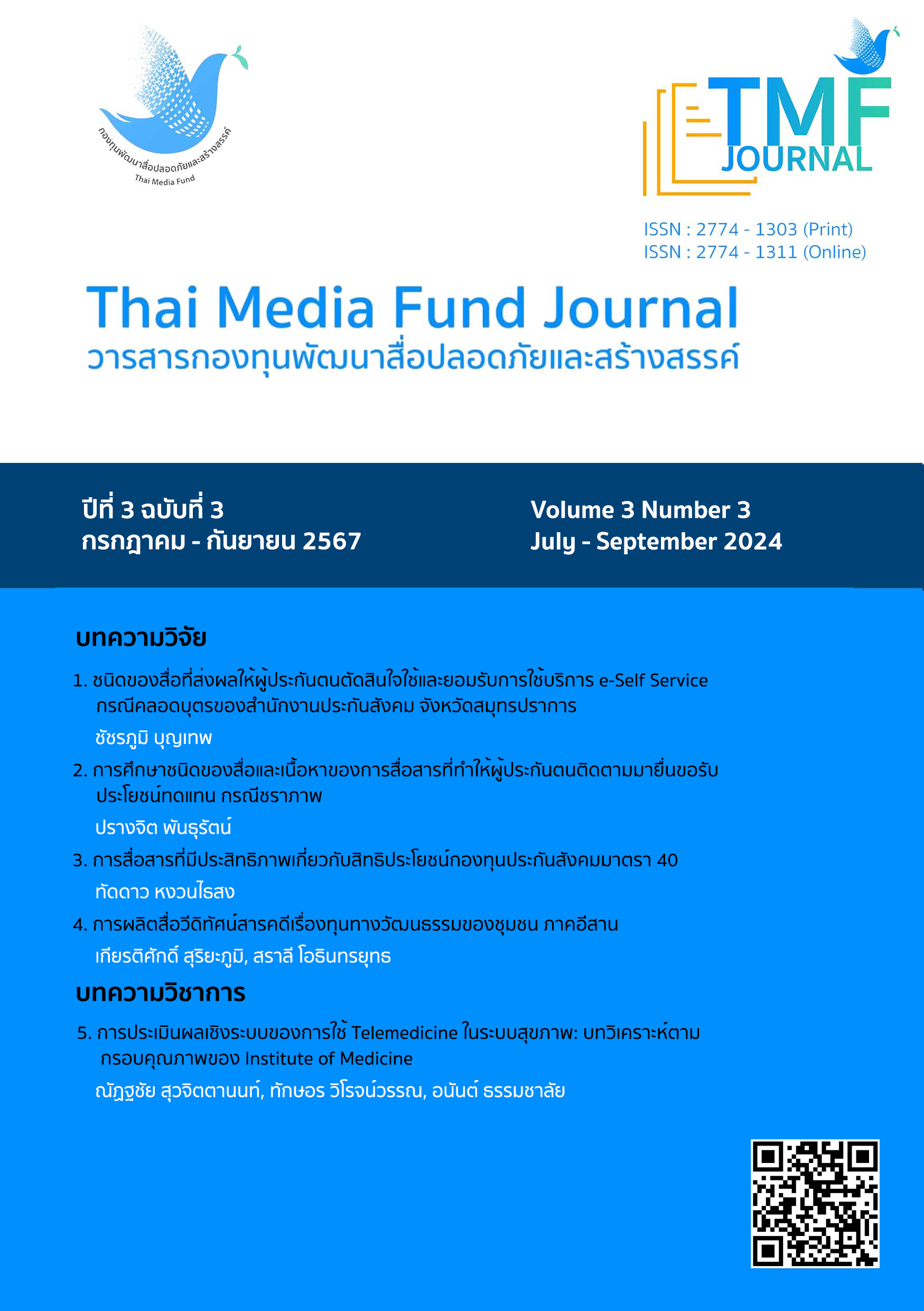ชนิดของสื่อที่ส่งผลให้ผู้ประกันตนตัดสินใจใช้และยอมรับการใช้บริการ e-Self Service กรณีคลอดบุตรของสำนักงานประกันสังคม จังหวัดสมุทรปราการ
Main Article Content
บทคัดย่อ
บทคัดย่อ
งานวิจัยนี้มีวัตถุประสงค์ 1) เพื่อศึกษาชนิดของสื่อที่สำนักงานประกันสังคม จังหวัดสมุทรปราการ ใช้สื่อสารกับผู้ประกันตนให้ตัดสินใจใช้
e-Self Service สำหรับยื่นขอรับประโยชน์ ในกรณีคลอดบุตร 2) เพื่อศึกษาความคิดเห็นของผู้ประกันตนต่อการใช้บริการผ่านระบบ e-Self Service สำนักงานประกันสังคม กรณีคลอดบุตร 3) เพื่อศึกษาปัญหาและอุปสรรคของผู้ประกันตนต่อการใช้บริการผ่านระบบ e-Self Service สำนักงานประกันสังคม กรณีคลอดบุตร เป็นการวิจัยเชิงคุณภาพ โดยการสัมภาษณ์เชิงลึกกับผู้ให้ข้อมูลหลักแบบเจาะจง จากเจ้าหน้าที่ส่วนงานสิทธิประโยชน์สำนักงานประกันสังคมจังหวัดสมุทรปราการ สาขาบางพลี จำนวน 8 คน ซึ่งมีคุณสมบัติเป็นผู้ประกันตนที่มีความมั่นใจจากติดต่อกับสำนักงานประกันสังคมทางสื่อออนไลน์ และศึกษารายละเอียดสิทธิประโยชน์ผ่านสื่อไม่สอบถามจากเจ้าหน้าที่ และสุดท้ายตัดสินใจใช้และยอมรับผลการใช้บริการ e-Self Service ระหว่างวันที่ 4-10 กรกฎาคม 2567 สถานที่สำนักงานประกันสังคมจังหวัดสมุทรปราการ สาขาบางพลี ผลงานวิจัย พบว่า 1) ผู้ประกันตนตัดสินใจใช้บริการ e-Self Service จาก Facebook สำนักงานประกันสัง 2) ความคิดเห็นต่อการใช้บริการผ่านระบบ e-Self Service สำนักงานประกันสังคม กรณีคลอดบุตร มีสะดวกรวดเร็วประหยัดเวลาและค่าใช้จ่ายในการเดินทางมาติดต่อยังสำนักงานลดปริมาณเอกสารประหยัดทรัพยากรกระดาษไม่ต้องถ่ายเอกสารหรือทำสำเนา 3) ปัญหาและอุปสรรคต่อการใช้บริการผ่านระบบ e-Self Service สำนักงานประกันสังคม กรณีคลอดบุตร ได้แก่ ผู้ประกันตนเข้าระบบไม่ได้ ลืมรหัสผ่านลืมเบอร์โทรศัพท์เพื่อรีเซ็ตรหัสผ่าน ไม่มีการแจ้งเตือนในการยื่นเรื่องหรือติดตามขั้นตอนการดำเนินการผู้ประกันตนไม่ทราบว่าสามารถยื่นผ่านระบบ e-Self Service สำนักงานประกันสังคม กรณีคลอดบุตรได้ เอกสารที่แนบในระบบ
ไม่ชัดเจนหรือไม่ถูกต้อง ทำไม่เป็น ไม่มีสมาร์ทโฟน ไม่มีอินเทอร์เน็ต และเกิดความยุ่งยากต่อชาวต่างชาติหรือต่างด้าวเนื่องจากระบบมีแต่ภาษาไทย ตามลำดับ
Article Details

อนุญาตภายใต้เงื่อนไข Creative Commons Attribution-NonCommercial-NoDerivatives 4.0 International License.
เอกสารอ้างอิง
Carol, K., & Joe, P. (2009). The web experience-trends in eService. Bedfordshire: Cranfield School of Management.
Davis, R. (2018). Historical perspectives on television's influence. In Media Archives, pp. 101-115.
Ghonh, S., & Antony, J. (2003). Determining and assessing of e-service operations. Managing Service Quality: An International Journal, 33-53.
Harris, J. (2020). The role of internet media in shaping consumer behavior. In Internet Media Quarterly, pp. B1-B3.
Johnson, M. (2018). The impact of digital media on society. Journal of New Media Studies, 5(2), 45-58. DOI:10.1234/jnms.2018.5.2.45
Morse, J. M. (1994). Designing funded qualitative research. In N. K. Denzin & Y. S. Lincoln (Eds.), Handbook of Qualitative Research (pp. 220–235). Sage.
National Economic and Social Development Board and National Social Development Board. (2009). National Strategy 2013-2037. Retrieved from http://www.sepo.go.th
Noiwong, K. (2016). Old-age benefits of the self-employed persons. An Independent Study of Master Of Political Science (Public Administration And Public Affairs) Executive Program in Public Administration and Public Affairs Faculty of Political Science Thammasat University.
Oliver, R. L. (1999). Whence consumer loyalty. Journal of Marketing, 63, 33-34.
Office of Planning and Information, Social Security Office. (2007). Social security manual. Retrieved from http://www.oic.go.th/FILEWEB/CABINFOCENTER2/DRAWER056/GENERAL/DATA0000/00000578.PDF
Office of Strategy and Planning, Office of the Permanent Secretary, Ministry of Labor. (2023). Ministry of labor policy for fiscal year 2024. Retrieved from http://www.mol.go.th
Kongkha, P. (2023). The use of electronic systems (e-Services) in registration and reporting of unemployed persons at the Prachinburi Provincial Employment Office. Independent study, Graduate School, Ramkhamhaeng University.
Roberts, S. (2018). Online journalism and its impact on public discourse. Digital Journalism Review, 5(3), 101-115. DOI:10.1234/djr.2018.5.3.101
Royal Institute Dictionary. (1999). Royal institute. Bangkok: Nanmee Books.
Smith, J. (2015). The influence of mainstream media on public opinion. Journal of Communication Studies, 25(3), 112-125. DOI:10.1234/jcs.2015.25.3.112
Smith, J., Brown, L., & Johnson, P. (2018). Social media influence on decision making. Academic Press.
Sodapadcha, Phosing, P., & Kenaphoom, S. (2017). The social welfare management approach: Government: Community organization. Humanities and Social Sciences Journal Ubon Ratchathani Rajabhat University, 8(2), 160-176.
Thompson, L. (2017). The influence of internet media on public opinion. Journal of Internet Studies, 10(2), 45-58. DOI:10.1234/jis.2017.10.2.45
Williams, C. (2020). The future of digital media platforms. In Online Media Perspectives, pp. A1-A5.
Wongaiyara, V. (2020). Factors influencing the adoption of the electronic social fund payment service (e-Payment) of social security fund. Master of Accountancy Program College of Innovative Business and Accountancy, Dhurakij Pundit University.


